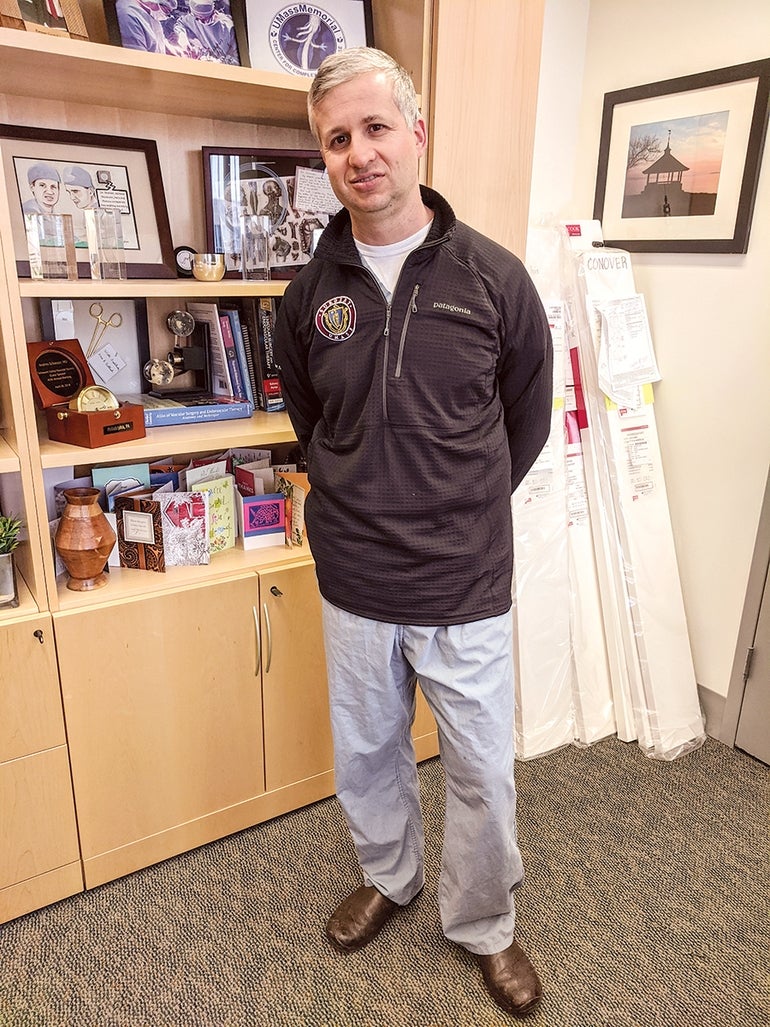Dr. Andres Schanzer is an endovascular surgeon who was recruited to be the center’s first director and today is sought to teach doctors worldwide on how to perform the work.
Get Instant Access to This Article
Subscribe to Worcester Business Journal and get immediate access to all of our subscriber-only content and much more.
- Critical Central Massachusetts business news updated daily.
- Immediate access to all subscriber-only content on our website.
- Bi-weekly print or digital editions of our award-winning publication.
- Special bonus issues like the WBJ Book of Lists.
- Exclusive ticket prize draws for our in-person events.
Click here to purchase a paywall bypass link for this article.
There was the Christmas Eve case in 2016, when a 14-year-old Rutland boy who had been in a serious car accident, suffered a rupture of an artery near his heart, known as an aortic aneurysm, and, with major internal bleeding in his abdomen, was in need of immediate surgery to save his life. Another time, on the Fourth of July, a Rochester, N.Y. man with the same aneurysm was determined by a hospital there to be a severe enough case surgery wasn’t possible – instead they would simply work to make him comfortable. In both cases, UMass Memorial Medical Center’s Center for Complex Aortic Disease was able to save a life thanks to its unique treatment capabilities. It is one of few such centers in the country able to conduct minimally invasive aortic grafts. That comes most in handy when the center needs on-call surgeons to rush an operation, in the first case of the boy; and to have someone fly in a graft, in the second case to save someone another hospital was unable to. It is one of only 10 hospitals to be part of a U.S. Food and Drug Administration trial on such minimally invasive aortic graft surgeries, and, according to UMass, the second busiest behind only the Mayo Clinic in Minnesota. The center, which performs up to 70 aortic surgeries a year, is led by Dr. Andres Schanzer, an endovascular surgeon who was recruited to be the center’s first director and today is sought to teach doctors worldwide on how to perform the work.
An aortic aneurysm is not a well-known condition. How severe is it?
An aortic aneurysm is a life-threatening condition. It’s a condition in general the public does not know too much about. One challenge is an aneurysm is asymptomatic: that is, it causes no symptoms at all. And then it becomes a life-threatening emergency. Anyone with a family history of hypertension or a cigarette smoker should be screened. Patients treated prophylactically do really well, while if you wait until they rupture and it’s life threatening, often in those situations, patients don’t do as well. It’s relatively common. It’s the 13th leading cause of death.
How often are operations here done in emergency situations?
Most of these, fortunately, can be done electively. We don’t want to wait years to fix it, but we can wait the one to three months it can take to get a CT scan and get the graft built and get it on site. For urgent cases of ruptures, we do have some devices made in such a way they can fit most anatomies. My preference is always to get a patient a device specifically made for them, but sometimes we don’t have the luxury of waiting.
UMass is able to operate laparoscopically, unlike procedures elsewhere or in the past requiring opening up the patient’s chest. How much does that change a patient’s recovery?
What’s really transformative for this kind of repair, when the repairs go well, is the patients usually go home in one to three days, and usually within two to four weeks are feeling back to normal. That’s in contrast to open surgery. I would say in the best of situations, it’s a three-to six-month month recovery, and a lot of patients don’t fully repair from an open repair like that. Some aren’t even a candidate for that, they’re sometimes told there’s nothing they can do.
The center is able to create a graft specially fit for each patient. How does it do that?
A couple hours in a CT scan will show a high-resolution image so we’re able to order a graft for their own anatomy, where the blood vessels are so it lines up just right. It becomes much more complicated for an operation, because you have to assemble inside a patient under X-ray guidance.
How did you get into medicine and into vascular surgery?
I knew I wanted to be a doctor. And while in medical school, I was really impressed with surgery, and the idea of being able to treat complex problems and ideally improve a patient’s functional status and quality of life relatively immediately. I found vascular surgery to be particularly fascinating. You have very long-term relationships with patients. I follow them their entire life. It’s also highly technically dependent. You really need to be technically skilled, and there’s a massive amount of innovation happening in the field.
This interview has been edited and condensed by WBJ News Editor Grant Welker.

